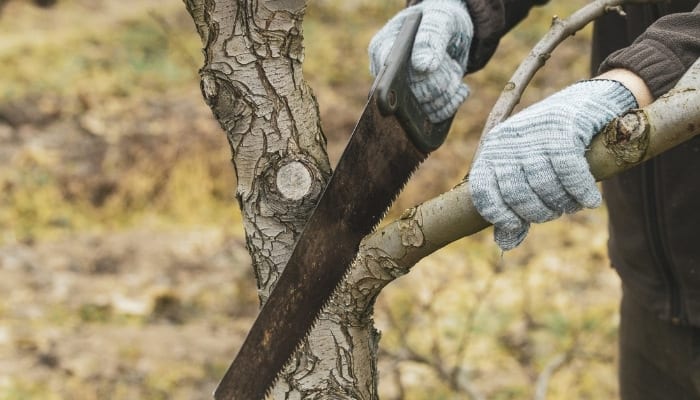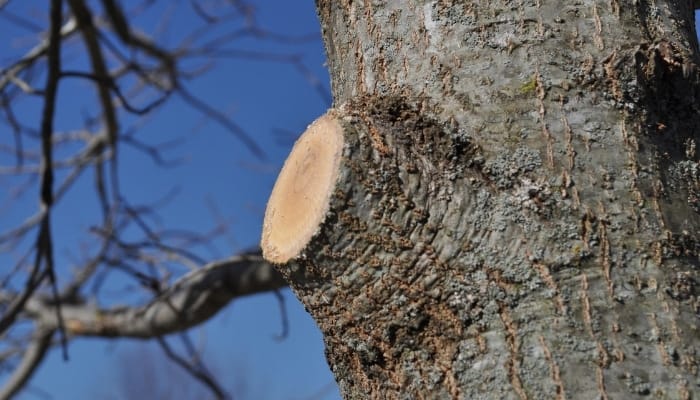The usage of tree wound sealer has been a widespread method for a considerable duration, however, is it truly the correct course of action?
Should you seal a wound on a tree? In most cases, it is better to let a tree heal its own wounds than to apply a tree wound sealer. Trees are usually able to mend their own wounds and damaged areas without intervention. Wound sealers trap moisture, inhibit natural callus formation, and can encourage fungus growth.
Read on below and learn everything you need to know about tree wound sealer before you use it or think about using it on your trees!
Is Tree Pruning Sealer Necessary?
Despite what you may have heard, using a tree pruning sealer after pruning your trees is not necessary. What is necessary, however, is a proper pruning technique.
Knowing when and where to cut your trees ensures that they are able to self-heal without complication.
Why You Should Not Use Tree Wound Sealer
There are several good reasons why you shouldn’t use tree wound sealer after cutting your tree’s branches.
The biggest reason is that using tree wound sealer products slows the natural healing process of the tree.
Other significant reasons not to use it include moisture getting trapped inside the tree as well as potential rot and decay setting in where you’ve pruned and sealed.
What Trees May Benefit From Tree Wound Sealer
Trees that are older or in a state of decline may benefit from tree wound sealer when pruning or when damages occur.
Trees susceptible to wilt diseases, such as oak and elm trees, may benefit from a wound dressing to avoid attracting insects that spread disease from tree to tree.
Trees that have a long life span ahead of them, whether fruit trees, landscaping, hedgerows, or otherwise, don’t benefit from tree wound sealer. In fact, it inhibits their growth and ability to heal afterward.
Types of Tree Wound Sealers
There are several types of popular tree wound sealers on the market, but four of them stand out from the rest.
The 4 most common types of tree wound sealers are:
1. Oil-Based Sealer
One of the most common types of sealer for tree wounds, oil-based sealer looks and smells like asphalt. Oil-based sealers may also contain petroleum.
While they may prevent insects from accessing the wound, they will not actually help the tree heal any faster.
2. Organic Sealer
The most effective type of tree wound sealer is the all-natural kind. That said, even these types of sealer can harm your tree if used improperly.
3. Latex Sealer
A new and improved version of asphalt-like sealers, latex sealer is less damaging to trees than oil-based sealer and even works as a safeguard against insects.
4. DIY Sealer
There are countless types of homemade recipes for DIY tree wound sealers, but try them at your own risk! One of the most popular and risk free is aloe gel.
How Do You Protect a Tree After Cutting a Branch?

The most common method for protecting trees after they’re cut/pruned is to apply a tree wound sealer, such as a commercial sealer, pruning stain, or pruning paint.
The least damaging to the tree tends to be the paint or stain as well as some organic/DIY sealers.
What Can Be Used as Pruning Sealer?
Pruning sealer products may contain a wide variety of materials, some organic and some man made.
The most common ingredients in commercial pruning sealers are asphalt, petroleum, and latex.
More friendly alternatives include organic sealers with base materials like aloe gel or collagen as the main ingredients.
Can I Seal a Tree Wound With Paint?
No one is going to stop you from painting your trees, and the neighbors probably won’t even think anything of it when they see you doing it.
However, that doesn’t mean that you should paint them after pruning or otherwise.
The paint is damaging to trees. It doesn’t actually speed up the healing process after pruning but increases the time it takes to heal instead.
Can I Seal a Tree Wound With Whitewash?
Despite what your grandpa told you (no disrespect intended… my grandpa is STILL telling me otherwise as well!), whitewashing trees as a form of protection from prune sealing isn’t recommended.
Once upon a time, whitewash was commonly accepted and taught as a standard best practice, but research has been done, the data has come in, and that ship has sailed.
Can Vaseline Be Used as Pruning Sealer?
Vaseline is probably one of the lesser evils from the majority of mainstream pruning sealers on the market.
However, it is still not highly recommended to use on most trees or plants.
The exception is heavy-bleeding evergreens trees like spruce and pines because the petroleum jelly isn’t as harmful to the tree; it works as a bug repellent and reduces bleeding.
Natural Pruning Sealer
Organic and all-natural pruning sealers are some of the best products on the market.
That said, using any pruning sealer after cutting the vast majority of trees is absolutely unnecessary regardless if it is a natural sealer or not.
The truth is, trees just heal better without our help.
You can find the product mentioned in the video above here.
Pruning Sealer Homemade
Believe it or not, the best way to help a tree heal IS by pruning. If a tree has a wound, pruning it back is the best option because the tree heals itself.
That’s why it’s important to know where and when to prune trees; if you cut them properly, no sealer is needed (homemade or otherwise).
Best Pruning Sealer
Now that you understand pruning sealers, let’s have a look at some of the most popular products currently available for sealing tree wounds:
If you do decide that your wounded tree needs a sealer, it’s important to select the least harmful option to give your tree the best chance of complete recovery.
Bonide Pruning Sealer
If you’re looking for a fast and easy way to seal branches after pruning trees, Bonide Pruning Sealer could be for you.
The dressing is breathable, petroleum-based, and generally less harmful than many other sealers.
It also helps protect the tree from pests, disease, rot, and water damage. It works well on trees, bushes, shrubs, and even roses. The container is 16 fluid ounces.
Treekote Tree Wound Dressing
For those looking for an asphalt-based tree wound dressing, Treekote may be worth looking into. The sealer protects against fungi, disease, pests, and water and comes in a 32-fluid-ounce container.
Unlike other sealers, it’s even tough enough to withstand winter conditions. That means it can be applied and remain effective all year long.
It is also classified as a grafting compound for those of you who like to experiment with grafting on rootstock.
Tanglefoot Tree Wound
The Tanglefoot Tree Wound sealer is an interesting and beneficial product that’s geared toward helping trees heal from wounds of all sorts. It is also marketed as a grafting compound.
Whether your trees have taken on damage from pests, the weed eater, or pruning, this dressing fits the wound. Furthermore, it provides protection against pests, weather, and disease and is easy to apply.
Tanglefoot Tree Wound Spray
The Tanglefoot Tree Wound Spray is probably the easiest product on the market to use when it comes to applying sealer to trees.
Regardless of how your tree was damaged, simply shake this can up, take the lid off, and spray the wound.
This spray comes in multiple sizes and works well on most trees, shrubs, and bushes. It’s fast drying and provides a weatherproof seal as well.
How To Apply Tree Wound Sealer
Your tree is pruned, you have your sealer in hand, and you’re ready to apply tree wound sealer.
Start by carefully reading the instructions on your sealer (unless it’s homemade) to avoid common/product-specific mistakes.
Unless it warns against using the product on the type of trees you have, head out to said trees.
Apply the sealer directly to the tree’s wound with a paintbrush or the brush/spray nozzle it comes with. You may need to apply it more than once, depending on the type of tree, wound, and sealer.
Conclusion
Using tree wound sealer isn’t necessary for most trees, but older trees, sick trees, oaks, elms, and many evergreen trees that have heavy sap flow may benefit from it.
Otherwise, the best way to help a tree heal from a wound, whether a broken branch or from sloppy pruning, is by performing a clean cut on the branch and allowing it heal naturally.

